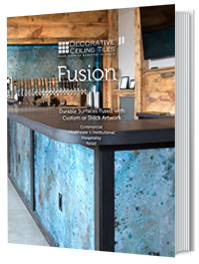What Are Ceiling Tiles Made Of? What You Need to Know About its Composition
Written by Milan Jara on 3rd Aug 2022

Homeowners need to ask what ceiling tiles are made of for several reasons. Not only should you consider the properties, but also the health effects.
Ceiling tiles are great at reflecting light, increasing the efficiency of your lighting system, and reducing energy consumption. Some will reduce or block noise as well. Ceiling tiles are made of a variety of materials. When selecting them, you need to consider the material composition and assess any negative health effects. So, what are ceiling tiles made of?
What Are Ceiling Tiles Made Of?
Ceiling tiles are composed of many materials, depending on which ones you are using. Each one has its own benefits, and some are better than others when it comes to different locations, such as the bathroom. Each material contains its own special properties, making them suitable for use as ceiling tiles.
Mineral Fiber Tiles

These tiles are frequently referred to as fiberglass ceiling tiles or acoustic ceiling tiles. They are popular for suspended ceilings. Mineral fiber tiles have recycled, natural, and processed components.
They may include recycled newspaper, clay, starch, perlite, and more. Different manufacturers will use various materials in different mixtures. As such, there may be a notable difference when comparing brands. These glue-up or https://www.decorativeceilingtiles.net/suspended-drop-ceiling-tiles/ are a popular choice for those who want to insulate a room against heat loss and noise.
Metal Ceiling Tiles

There's a lot to choose from with this material, including brass, copper, aluminum, or tin ceiling tile. They are durable and long-lasting, which means they are a great investment for a home. Despite not being able to absorb sound as efficiently as metal fiber tiles, some use soundproofing strips cleverly concealed in the suspended ceiling cavity.
Wood Ceiling Tiles

Most of these tiles are MDF and use a wooden veneer, reducing the expense and weight of your tiles. If they are 100% wood, they wouldn’t be a feasible option. Wood drop ceiling tiles are selected for aesthetic purposes and come in many finishes.
PVC (Polyvinyl chloride) Tiles

PVC ceiling tiles are composed of a material that is a lightweight plastic. They are factory manufactured into ceiling tiles of various designs, sizes, and colors. The panels contain a hollow core accompanied by a shiny, smooth surface.
Since they are waterproof, they are a great substitute for mineral fiber ceilings when placed in high moisture areas. These tiles are durable, and they last for years without bending or warping. They are also not as brittle as other materials and less likely to become damaged.
The one warning, however, that does come with these tiles is not to use them in kitchens. PVC is very toxic (emits traces of chlorine gas over a prolonged period) when burnt.
Things to Consider
Healthy ceiling tiles should be recyclable and recycled, and Green guard certified against dangerous emissions. In high moisture areas, consider perlite, clay, or metal materials. Avoid formaldehyde glues, biocides, and antimicrobial treatments.
When looking to install suspended ceiling tiles, avoid those with air-polluting chemicals. Mineral fiber and some fiberglass panels use formaldehyde, a carcinogen that can irritate the respiratory tract. Some tiles have antimicrobial treatments or are chemical flame retardants. The best tiles are those with recycled content or that can be recycled when you are finished with them.
Ceiling Tiles to Avoid
There are tiles you want to be wary of, especially when it comes to older ceiling tiles, as they may contain asbestos. Other materials contain some potential health risks, too, so you need to read the safety specs before buying them. Experts recommend reviewing the tiles' material safety data sheet.
Asbestos
Homeowners need to be careful with ceiling tiles installed before 1981 as they may contain asbestos. Inhaling these fibers can lead to lung diseases like mesothelioma, cancer, and asbestosis. If you suspect this is the case with your home, view the tips found in the Consumer’s Guide to Asbestos.
If the tiles are not disturbed and in good condition, exposure risk is low. However, if they are damaged in any way or you are doing ceiling work, contact a licensed contractor for the safety of the household.
Flame Retardants
Despite some ceiling tiles being naturally fire-resistant, some companies add a toxic chemical flame retardant. However, it can be difficult to know if the tiles contain this coating as companies aren’t required to disclose their use on websites or labels. You may need to contact the manufacturer to find out.
Antimicrobial Coatings
There is no evidence to support that this treatment will prevent disease. Some common ones include triclosan and silver-based compounds, which can be harmful to the environment and your overall health. The risks tend to outweigh any potential benefits.
Instead, purchase tiles with moisture-resistant materials like metal, clay, or perlite. They are a wonderful option to prevent mold in high humidity and high moisture areas.
Microbes
If you are considering acoustic ceiling tiles, some contain porous materials that can breed fungi, mold, and bacteria. They have been correlated to respiratory issues like bronchitis, asthma, sinus problems, and respiratory infections.
Humidity control and a good ventilation system can prevent the growth of these microbes. The U.S. Center for Disease Control and Prevention states these methods should be used instead of the antimicrobial treatments often added to the tiles.
Formaldehyde
Glues that bind composite materials for ceiling tiles can contain formaldehyde. Formaldehyde is a respiratory irritant and carcinogen. Some types of ceiling panels use phenol-formaldehyde as binding agents. Recycled materials in tiles can also contain this element.
Conclusion
When looking for your next ceiling tile, you may want to ask yourself what ceiling tiles are made of. Each type contains different properties with some being better for your health than others. You will also need to consider what your old tiles are made of as there is always the risk of asbestos exposure.




